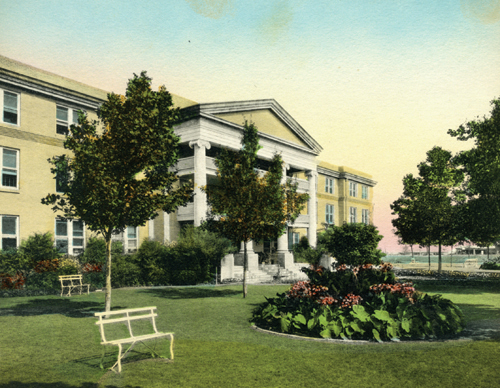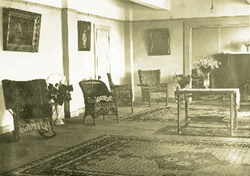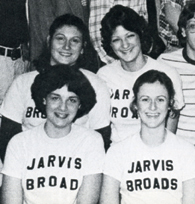|

Oh the stories it could tell
The walls will come tumbling down on the historic Brown-Lupton Student Center in June, paving the way for a new academic building to be called Clarence and Kerry Scharbauer Hall. As we look back through its 53 years of campus life, think about the stories you could tell about the old student center and send them to us. We'll share them in a future issue.

By Rick Waters '95
1910 For a mere $126,500, TCU starts construction on a woman's dormitory and an administration building (now Dave Reed Hall) on the open prairie west of Fort Worth. A men's dorm, Goode Hall, is financed separately. Classes are held downtown as the campus is built.
1911 Jarvis Dormitory opens in the fall with the Admin Building and Goode Hall. Just 175 feet by 45 feet, Jarvis is called the "Girls' Home" and divided into 80 dormitory rooms designed for double occupancy. It also contains an attractive and comfortable first floor parlor that would become the university's social center for 31 years. It was the venue for receptions for visiting dignitaries, faculty woman's club teas, senior women's teas, and other students' events.
June 12, 1912 Girls' Home is "christened" by trustees and named for Major J.J. and Ida Van Zandt Jarvis, lifelong supporters of the university. Major Jarvis, a Fort Worth lawyer and businessman, was a financial benefactor to Add-Ran College when it relocated from Fort Worth to Thorp Spring in 1873. When the college was chartered in 1889 as Add-Ran University (today spelled AddRan), Major Jarvis was elected the first president of the Board. Ida, in 1935, acknowledged authoring the 1889 charter, making Add-Ran College a university. In 1895 Ida was the supervisor of the Girls' Home at Thorp Spring. In 1915 she established the University's School of Home Economics, believing that every young woman should be taught how to sew and to cook. In 1931 she was the first woman elected to the Board of Trustees and served in that capacity until her death in 1937.
 1923 With no church near TCU, much less a funeral chapel, the Jarvis parlor serves as the location of the funeral of Frank L. Harris, the steward of the campus' first cafeteria-style dining room. Harris is the grandfather of longtime TCU historian Joan Hewatt Swaim '56. 1923 With no church near TCU, much less a funeral chapel, the Jarvis parlor serves as the location of the funeral of Frank L. Harris, the steward of the campus' first cafeteria-style dining room. Harris is the grandfather of longtime TCU historian Joan Hewatt Swaim '56.
1933 Sadie Beckham, Jarvis dorm matron and dean of women, uses the parlor (photo left) as a gallery of TCU "past, present and future." Beckham hatched the idea when Mrs. Jarvis presented the institution with portraits of herself and Major Jarvis. This led Beckham to search for other important photos. The gallery, which the Skiff termed "the campus Louvre," would eventually display photographs of Addison and Randolph Clark, the 1914-15 staffs of the Horned Frog and Skiff, and the 1915 Glee Club. Beckham also included photos of grandchildren of administrators and faculty.
1934 After hearing numerous pleas for a place to dance on campus, Beckham announces that Jarvis will convert two rooms north of the parlor on the first floor into a recreation room. A hardwood floor is secured through a donation, although women of Jarvis are asked to donate 75 cents per plank. Total cost: $47.12. Dancing would be permitted 5 to 7:30 every night but Sunday. It was Mrs. Sadie who stood on the front steps of Jarvis each evening at 7, ringing her cow bell to summon her charges into the fold for the night. In her time young ladies living on the campus were not permitted out "after hours," nor to "date," dawdle, and certainly not to dance (outside the safe confines of Jarvis Hall).
1942 Jarvis is home to men for brief periods in the 1940s during World War II. Jarvis women are moved to the brand-new Foster Hall to make way for sailors from the U.S. Navy. An October 1942 Skiff article reported that "college boys foresee difficult dating competition."
1948 The hall's first floor office, parlor, music room, recreation room, kitchen, hostess quarters and faculty lounge are renovated for $2,500 to make room for the Yale Institute of Alcoholic Studies and for the campus' first language laboratory for the Department of Foreign Language. The Yale Institute occupies the space until 1951 when the program is discontinued. In 1960 the language lab is moved to Sadler Hall.
1950-53 Overcrowding dictates that Jarvis space again be assigned temporarily to male residents.
 1955 Jarvis is renovated again, for $250,000, as part of Chancellor M.E Sadler's building program. This time the distinctive second- and third-story balconies suspended between the central columns are removed. New bathroom fixtures and modern kitchen facilities are among the notable upgrades. Central air-conditioning was supposed to be included but wasn't. 1955 Jarvis is renovated again, for $250,000, as part of Chancellor M.E Sadler's building program. This time the distinctive second- and third-story balconies suspended between the central columns are removed. New bathroom fixtures and modern kitchen facilities are among the notable upgrades. Central air-conditioning was supposed to be included but wasn't.
1968-69 Jarvis women join the men of Tom Brown dormitory in establishing the Tom Brown-Jarvis Experiment, or TB-J, Inc. The organization sponsors speakers and organizes canned food and blood drives. But the group is most remembered for attempting to bring academic courses inside the two dorms and clashing with Chancellor Moudy over the university's first 24-hour lobby visitation policy (which he eventually conceded) and co-ed living (which he did not). In the fall of 1974, the Jarvis lobby would be open 24 hours on an experimental basis, joining the men's dorms, which already enjoyed the same privilege. Jarvis residents report no hassles.
1979 A Restore Jarvis Committee attempts to qualify the hall for a medallion from the Texas State Historical Society. Committee members push for the building's exterior to be returned to its original look, complete with balconies on the second and third floors. In August, women of Jarvis return for the fall semester to find the dorm's old wooden window frames replaced with aluminum, thus eliminating the chance to get the structure declared a national historic building. Then-Director of Housing Don Mills says the administration made the decision as part of "a campus-wide energy conservation effort."
 1987 Jarvis wins the inaugural Libby Proffer Award for the residence hall (the term "dorm" is deemed old-fashioned) with the highest grade-point average. The women of the hall would win the next three Proffer Awards and hold the most of any dormitory. 1987 Jarvis wins the inaugural Libby Proffer Award for the residence hall (the term "dorm" is deemed old-fashioned) with the highest grade-point average. The women of the hall would win the next three Proffer Awards and hold the most of any dormitory.
1989 A survey by the Historic Preservation Council of Tarrant County considers Jarvis "individually eligible" for the National Register of Historic Places "following the sympathetic rehabilitation of the windows," (which has not been done yet).
2007-08 The end of an era: Jarvis closes in December 2007 and will reopen in August 2008 with the School of Music expanding into the third floor, allowing the theater department to use the entire second floor of Landreth Hall. The first and second floors of Jarvis will become office space for Student Affairs, Career Services, Campus Ministries, and International Student Services.
Send your memories of Jarvis Dormitory to tcumagazine@tcu.edu, or by snail mail to TCU Box 298940, Fort Worth, TX 76129, or call 817.257.5059.
Comment at tcumagazine@tcu.edu.

|



